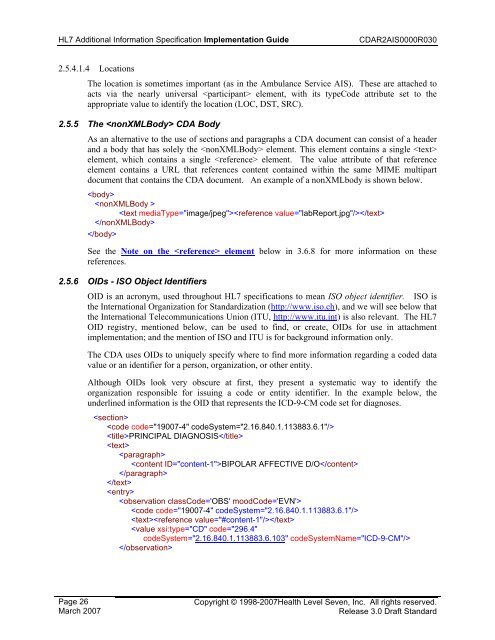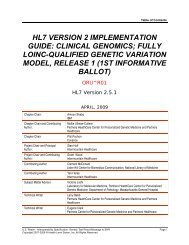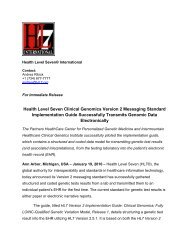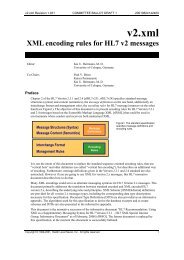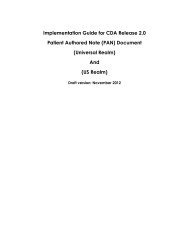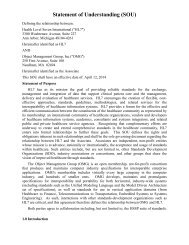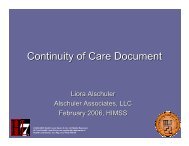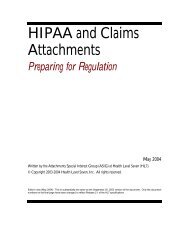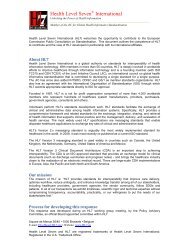<strong>HL7</strong> Additional Information Specification <strong>Implementation</strong> <strong>Guide</strong><strong>CDA</strong><strong>R2</strong><strong>AIS</strong>0000R0302.5.4.1.4 LocationsThe location is sometimes important (as in the Ambulance Service <strong>AIS</strong>). These are attached toacts via the nearly universal element, with its typeCode attribute set to theappropriate value to identify the location (LOC, DST, SRC).2.5.5 The <strong>CDA</strong> BodyAs an alternative to the use of sections and paragraphs a <strong>CDA</strong> document can consist of a headerand a body that has solely the element. This element contains a single element, which contains a single element. The value attribute of that referenceelement contains a URL that references content contained within the same MIME multipartdocument that contains the <strong>CDA</strong> document. An example of a nonXMLbody is shown below.See the Note on the element below in 3.6.8 for more information on thesereferences.2.5.6 OIDs - ISO Object IdentifiersOID is an acronym, used throughout <strong>HL7</strong> specifications to mean ISO object identifier. ISO isthe International Organization for Standardization (http://www.iso.ch), and we will see below thatthe International Telecommunications Union (ITU, http://www.itu.int) is also relevant. The <strong>HL7</strong>OID registry, mentioned below, can be used to find, or create, OIDs for use in attachmentimplementation; and the mention of ISO and ITU is for background information only.The <strong>CDA</strong> uses OIDs to uniquely specify where to find more information regarding a coded datavalue or an identifier for a person, organization, or other entity.Although OIDs look very obscure at first, they present a systematic way to identify theorganization responsible for issuing a code or entity identifier. In the example below, theunderlined information is the OID that represents the ICD-9-CM code set for diagnoses.PRINCIPAL DIAGNOSISBIPOLAR AFFECTIVE D/OPage 26March 2007Copyright © 1998-2007Health Level Seven, Inc. All rights reserved.Release 3.0 Draft Standard
<strong>HL7</strong> Additional Information Specification <strong>Implementation</strong> <strong>Guide</strong><strong>CDA</strong><strong>R2</strong><strong>AIS</strong>0000R030An OID is a globally unique string consisting of numbers and dots (e.g.,2.16.840.1.113883.6.103). This string expresses a tree data structure, with the left-most numberrepresenting the root and the right-most number representing a leaf.Each branch under the root corresponds to an assigning authority. Each of these assigningauthorities may, in turn, designate its own set of assigning authorities that work under itsauspices, and so on down the line. Eventually, one of these authorities assigns a unique (to it asan assigning authority) number that corresponds to a leaf node on the tree. The leaf may representan assigning authority (in which case the @S attribute identifies the authority), or an instance ofan object. An assigning authority owns a namespace, consisting of its sub-tree.<strong>HL7</strong> is an assigning authority, and has the OID prefix "2.16.840.1.113883." Any OID that beginswith this is further described by a registry maintained by the <strong>HL7</strong> organization. For example, theOID 2.16.840.1.113883.6.103 (above) was established by <strong>HL7</strong> as a globally unique identifier forthe ICD-9-CM code set for diagnoses 7 .The numbers in the <strong>HL7</strong> OID indicate that:• The OID was assigned by a joint ISO-ITU (2.) assigning authority,• it is specific to the country (16.)• of the USA (840.)• and is specific to the organization (1.)• known as Health Level Seven (113883.).Beyond that, the <strong>HL7</strong> organization assigns any numbers - and these are maintained in a registryavailable on the <strong>HL7</strong>.org website. <strong>HL7</strong> uses its registry to assign OIDs within its branch for <strong>HL7</strong>users and vendors upon their request. <strong>HL7</strong> is also assigning OIDs to public identifier-assigningauthorities both U.S. nationally (e.g., the U.S. State driver license bureaus, U.S. Social SecurityAdministration, US National Provider Identifier (NPI) registry, etc.) and internationally (e.g.,other countries' social security administrations, citizen ID registries, etc.)Additional reference information about OIDs, including the current directory of OIDs assigned by<strong>HL7</strong>, is available at http://www.hl7.org/oid/index.cfm. Organizations that wish to request anOID for their own use (e.g., to be able to create identifiers within a <strong>CDA</strong> document), may alsoobtain one from <strong>HL7</strong> at this site.2.5.6.1 Placeholder OIDs(New section) Add discussion similar to what is in the Ballot ReadMe file, geared towardsimplementers [Conny-21] mention <strong>AIS</strong> specification documents and example files.2.6 Rules for Constructing Attachment DocumentsAll attachment documents are <strong>HL7</strong> <strong>CDA</strong> documents. Attachment-specific Additional InformationSpecifications specify the content for all attachments, additionally; they specify the code(s) to beused for the computer-decision variants.7 The <strong>HL7</strong> Vocabulary TC retired 2.16.840.1.113883.6.2 in 2004 in favor of two separate code sets, one for ICD-9-CM diagnoses, and another for ICD-9-CM Procedures.Copyright © 1998-2007 Health Level Seven, Inc. All rights reserved.Release 3.0 Draft StandardPage 27March 2007


